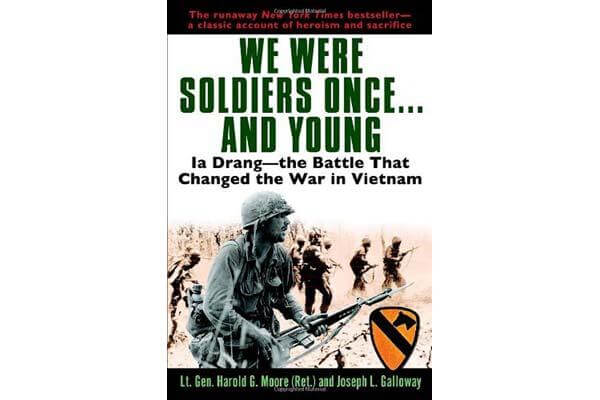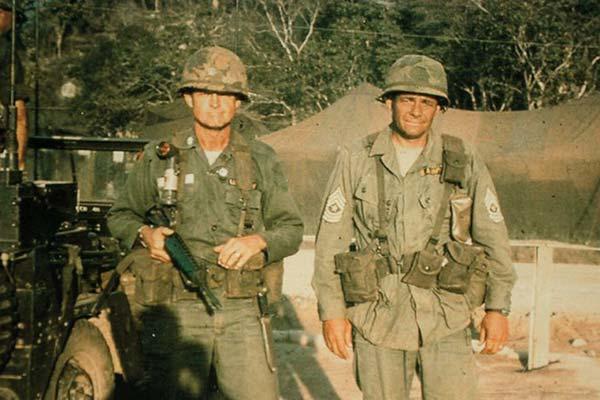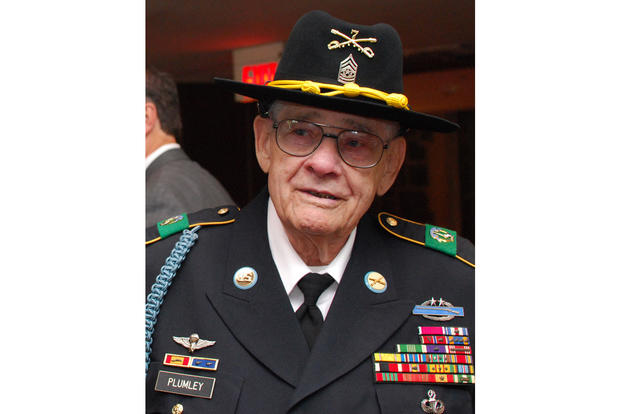The U.S. Army is investigating allegations by a military researcher that the late Command Sgt. Major Basil Plumley -- a legend in the airborne and infantry communities -- wore unauthorized combat and valor awards that exaggerated the wartime achievements that made him famous.
Plumley, who died Oct. 10, 2012 from cancer at the age of 92, was a major figure in the 1992 book, "We Were Soldiers Once … and Young," coauthored by Joseph L. Galloway and retired Lt. Gen. Harold G. Moore.
The book was moving account of the November 1965 Battle of Ia Drang Valley in the Vietnam War and the heroic fight that 450 soldiers of the 1st Battalion, 7th Cavalry, put up against a superior force of 2,000 North Vietnamese soldiers at LZ X-Ray.
Brian Siddall, an independent researcher whose father and uncle served during World War II -- the latter as a paratrooper who was killed during the D-Day invasion of Europe -- leveled the allegations against Plumley after an extensive study of his service records. He said he has been doing research for his website for the last decade.
"It's been a lifelong thing for me," he told Military.com. "My uncle was killed on June 6, 1944. He was a paratrooper in Company B of the 307th Airborne Engineers."
Siddall added, "Even as a kid, I used to ask my father -- because it was his kid brother -- what happened to him, and he didn't have an answer. And by the way, my dad was a navigator on a B-17 in World War II."
His research into Plumley's famed exploits in the 82nd Airborne Division during World War II later prompted him to write two online articles in 2015 that show discrepancies between Plumley's service records and the awards and actions he took credit for.
According to Siddall, who obtained Plumley's service records, Plumley inflated his heroism in battle by wearing two Silver Stars and Bronze Star medals for valor in combat instead of wearing the single Silver Star he was awarded in Vietnam.
Plumley also exaggerated the number of Combat Infantry Badge awards he was authorized, Siddall maintains. The CIB is a sacred award only bestowed upon infantrymen for engaging in direct combat with the enemy.
In light of Siddall's research, officials at Fort Benning, Georgia, are investigating the allegations and are considering Siddall's request to have the information on Plumley's headstone corrected.
An Airborne Legend
In "We Were Soldiers Once … and Young," Plumley is described as "a two war man and wore master parachutist wings with five combat-jump stars," referring to Plumley's service in World War II and the Korean War.
"Plumley had survived all four combat jumps of the 82nd Airborne Division in World War II: Sicily and Salerno in 1943, and then in 1944, D day at Normandy, and Market-Garden in the Netherlands," according to the book. "For that matter, he also made one combat parachute jump in the Korean War, with the 187th Airborne Infantry Regiment."
In the 2002 Hollywood movie "We Were Soldiers," Actor Mel Gibson, playing then Lt. Col. Moore, gave a similar description of Plumley, who was played by actor Sam Elliott.
Siddall argues Plumley's records show that he served in 320th Glider Field Artillery Battalion as a scout. Plumley was Glider, meaning he was an 82nd Airborne Division gliderman, not an 82nd Airborne Division paratrooper, Siddall writes.
As a scout, Plumley's job was to search out locations for emplacements for the 105mm guns, according to Siddall.
The 320th participated in two glider assaults in the European Theater, Siddall writes. Plumley's first was on June 6, 1944, during the invasion of Normandy, he writes. Plumley's second was for Operation Market Garden on Sept. 18, 1944, he writes. Plumley was shot in the hand the same day, according to copies of Army records in Siddall's articles.
Glider operations in WWII were extremely dangerous. The plywood Waco and Horsa gliders presented larger targets to enemy ground fire and often crash landed, resulting in heavy casualties, according to historical sources.
Plumley was authorized to wear the glider badge and master parachutist wings, according to Army records. Plumley graduated a jump school set up by the 82nd Airborne Division in 1943, Plumley's records show.
But Plumley never served in Korea during the Korean War, so he couldn't have participated in one of the two combat jumps of that conflict, according to Siddall's research.
"When you look at his overseas assignments it speaks for itself," he wrote. "Look where Plumley was between 1951 through 26 February 1953, Ft. Campbell, Kentucky then he went to Germany," he wrote, adding that Plumley's service records show him serving in Korea in 1972-73.
"When I spoke with him in July of 2011, he never claimed to have jumped out of an airplane in combat in WWII or any other wars," Siddall writes. "He did talk briefly about that he jumped out of helicopters but never an airplane in wartime."
Talking to Military.com, Siddall said, "We talked for seven minutes on Skype. I asked him about the four jumps and he laughed and said 'no'" he had never jumped from a plane in combat.
The reason he got really interested in doing research on Plumley was after he noticing Galloway's obituary on Plumley contained the same exaggerations about Plumley's career, Siddall said.
Exaggerated Achievements
The best-selling book and the Hollywood movie elevated Plumley to celebrity status long after his retirement from the Army in 1974.
A May 2010 photograph of Plumley appearing at the U.S. Military Academy at West Point in an Army Dress Blue uniform shows him wearing a Combat Infantry Badge with two stars -- which means three CIB awards -- one for WWII, one for the Korean War and one for the Vietnam War, Siddall maintains.
Plumley's service records show he was only authorized to wear one CIB for his service in Vietnam, Siddall argues.
"When Plumley retired December 31, 1974 on his DD 214 he had 2 CIBs listed not three," Siddall wrote. "When Plumley was interviewed by Galloway for the book he said he had three CIBs by that time (early 1990s). The Awards and Decorations Branch has Plumley listed as one, not three CIBs. Plumley didn't meet the criteria for WWII and wasn't in Korea so his first and only CIB was in Vietnam."
Among the many documents Siddall provides in his research is an Oct. 2, 2015, letter from Army Lt. Col Wil Neubauer, chief of Awards and Decorations Branch, confirming that Plumley was authorized to wear one CIB and states that "we are unable to verify" the Combat Infantry Badge with "one star" listed on Plumley's DD Form 214.
Click Here to See the Army's Oct. 2, 2015, Memo on Plumley's Awards.
In that same photo, Plumley wore valor awards he did not earn, Siddall wrote. Plumley wore a Silver Star with a bronze oak leaf cluster, which indicates a second Silver Star. Plumley also wore a Bronze Star with a V device for valor and one bronze oak leaf cluster for two awards.
The October 2015 letter from the Army states Plumley was authorized only one Silver Star and the Bronze Star with one oak leaf cluster, not two OLCs. The letter also states that Plumley was not authorized to wear the V device with his Bronze Star medals.
True Heroism
What's indisputable is that Plumley did earn a Silver Star for courage and valor he showed during the Battle of Ia Drang Valley.
In the early-morning hours of Nov. 16, 1965, the command post of the 1st Battalion, 7th Cavalry, fell under heavy attack.
"The command post was being savagely attacked by an unknown number of Viet Cong," according to a copy of Plumley's Dec. 27, 1965, Silver Star Citation.
Enemy automatic weapons fire was pouring into the forward command post and aid station area, which was located about 150 meters behind the "line of contact," it states.
"At approximately 0500 at the height of the savage attack, a flare, still burning landed in an open box of fragmentation hand grenades in the pile of small arms, mortar and other ammunition less than 10 meters from the battalion command group," according to the document.
"Sergeant Major Plumley, voluntarily and unhesitatingly, rose up in the face of intense small arms and automatic fire, dashed to the burning flare, lifting it with his bare hands out of the box of grenades and threw it. He extinguished the flare with his feet as well as other small fires which it had ignited around the ammo area," it states.
Plumley's brave action, it goes on, "performed under fire with complete disregard for his own personal safety, undoubtedly prevented the complete ammunition supply from exploding."
In his research, Siddall acknowledges that "Plumley received the Silver Star Medal for what he did, and it was important," Siddall writes. But, he adds, "that wasn't enough for someone like Plumley. Plumley had to build himself up even more. For Plumley to be seen wearing the Combat Infantryman's Badge with the 3 CIB Badge at West Point in 2010 was disgusting."
Military.com contacted Galloway about Siddall's research and why Plumley's service records contradict what Galloway, the only journalist present at LZ X-Ray, wrote about about Plumley. Military.com sent Galloway Siddall's two articles, which contained hyperlinks to Plumley's service records.
Galloway wrote the following response by email:
"I don't know a thing about Mr. Siddall and his research that slanders a fine old soldier who died four years ago and can't speak for himself.
"My co-author Lt. Gen. Hal Moore vouched for CSM Plumley when we were working on the books. I read the Plumley biography when Moore and Plumley received the Doughboy Award quite a few years ago. It sure looked official to me and matched details I had been told about his service. I have no interest in commenting on this any further."
The Doughboy Award is presented annually to recognize an individual for outstanding contributions to the United States Army Infantry. The award is a chrome replica of a helmet worn by American Expeditionary soldiers during World War I and the early days of World War II.
Plumley's Headstone
Siddall sent his findings to Fort Benning in late 2015 and asked if the information on Plumley's headstone was going to be corrected.
Fort Benning officials eventually referred Siddall to Army Human Resources Command's Awards and Decorations Branch.
Military.com contacted Benning on May 4 about Siddall's request.
Col. Andy Hilmes, the garrison commander for Fort Benning, said his office is reviewing the request and that it's possible Plumley's headstone will be corrected.
The issue is the information in question on Plumley's headstone -- which reads "Silver Star with OLC" and "BSM W/V 2nd OLC" -- comes from Plumley's DD 214, the Army's separation of service form.
Hilmes acknowledged Siddall's research of Plumley's records shows several discrepancies and that Plumley's DD 214 does not match the official letter from the Army's Awards and Decoration Branch stating there is no verification that Plumley is authorized more than one Silver Star or the Bronze Star Medal with V Device for Valor with a second oak leaf cluster.
"I want to do the right thing," Hilmes said. "I have looked at how do we go about changing the headstone. … I can't change the DD 214 at Benning; that is really up to the Department of the Army."
Fort Benning reached out to Plumley's daughter, who is currently looking through her father's records.
Among the records she sent to Benning is a diploma from the 82nd Airborne Parachute School, stating that Plumley became a qualified parachutist on March 11, 1943. The document is signed by Maj. Gen. James M. Gavin, commander of the 82nd Airborne during World War II.
The documents she sent, however, contain no mention of any combat jumps in WWII or the Korean War.
The plan is to forward all of Plumley's personal records to Army Human Resources Command for a further review, according to Benning officials.
Military.com tried to contact retired. Lt. Gen. Harold Moore, who commanded the 1st Battalion, 7th Cavalry, in the Battle of Ia Drang Valley, but he "suffers from advanced dementia and is unable to discuss this matter," according to his son Dave Moore in an email to Military.com.
"Having read the allegation and scanned portions of Mr. Siddall's extensive research, it is clear that discrepancies exist," Dave Moore wrote the email. "The fact that the DoD could not verify all of the CSM's awards is not surprising given the lack of rigor in the maintenance of records in the 1940s. I am confident that my father wrote the truth as he knew it, and that Mr. Galloway accepted that truth. I am confident there was no willful intention to deceive readers."
Steve Moore, another son of Lt. Gen. Moore's sons, said even his own father was the victim of poor record-keeping when he was being added recently to Fort Leavenworth's International Hall of Fame.
"As part of that process, they coordinated with the family to obtain [Moore's] bio and other material," Steve Moore wrote in an email. "One of the items they shared with us was the current bio the General Officer Management Office (GOMO) had for Dad. We were horrified. It showed him with a CIB with 2 stars and added an extra award of the BSM/V and other medals.
"Apparently, the clerk who assembled the list years ago did not know that an oak leaf cluster represented the 2nd and subsequent award. So "CIB(2Awd)" on Dad's DD214 became a CIB with 2 stars, added extra BSM/V … Thank goodness we fixed this before there were any stolen valor accusations."
Siddall says he just wants the record about Plumley to be corrected.
"I just want the correct information out there because there are so many people that are really heroes, and it is so frustrating when they give the hero status to someone who was anything but," he said.
Military.com also reached out to Doug Sterner, curator for Military Times Hall of Valor, for his insight into this story. Sterner, who has been compiling and digitizing military awards for more than 20 years, has exposed many individuals for stolen valor, or wearing unauthorized military awards.
Sterner said he doesn't see the point in bringing up the discrepancies about Plumley, a man he calls a "genuine hero" because he earned a Silver Star in battle. He said he knows of hundreds of cases in which soldiers have been awarded Silver Stars or other valor awards and the records cannot be found.
"I don't see the point in trying to be so historically accurate we destroy a genuine hero," Sterner said.
--Matthew Cox can be reached at matthew.cox@military.com.

































